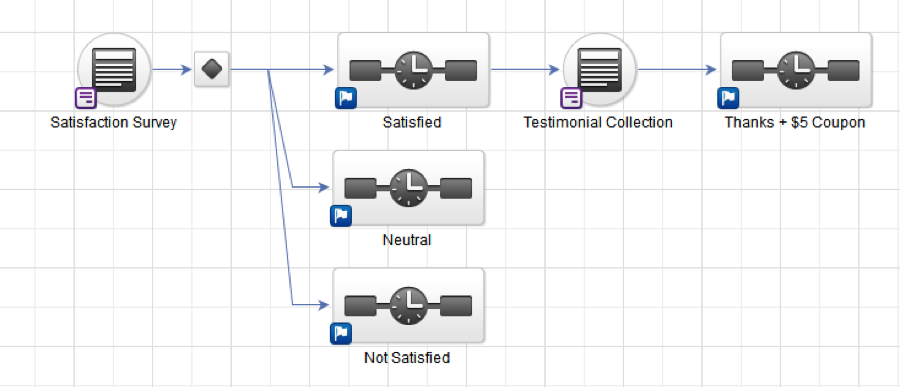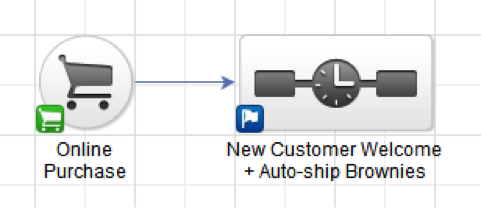by Paul Sokol
Ever hear of an electric toothbrush? Surely you have. Seems like a completely normal device, right?
Back in the 1950s, such a notion was completely absurd. That is until Philippe Woog invented the first electric toothbrush in 1954. Up until that point, most people probably hadn't even considered an automatic toothbrush.
Now, it seems so obvious.
That kind of "Duh, why didn't I think of that?" moment is exactly what we are hoping to achieve with this post. Hopefully somewhere in the words that follow you'll realize a new way to use automation in your business that you’d never thought of before.
Let’s start with attracting leads through automation using Infusionsoft, how you target an audience then attract, and capture their information so you can follow up with them.
1. Ask your (happy) customers
You are probably aware that it is cheaper to sell to an existing customer than it is to acquire a brand new customer. You probably also know that word-of-mouth advertising is some of the most influential kind of marketing available.
How can you leverage these two facts to generate more leads? Ask only your happiest customers who they know that might also benefit from what you offer.
Think about it: A happy customer is clearly, well, happy with the product or service they received, so they are most likely already sharing their experience with friends. Those friends are actually warm leads and warm leads are much easier to close.
You can use automation to determine which of your customers are happy by giving them a quick survey and then asking for a referral only from those people. Seems really simple right? That's because it is.
2. Validate your targeting
The first thing you have to do when strategizing how to acquire new customers is to get abundantly clear on exactly who is in your target market.
And don't say "everyone" either; that's a lazy cop out, #sorrynotsorry. It’s the whole "If you're for everybody, you’re for nobody" mindset. In other words, you have to have a clear target in mind in order for your marketing to be effective.
Is it possible you have more than one target? Sure. McDonald’s is definitely targeting children as well as adults, but both targets need to see vastly different messages before they eat a meal there (a toy helps too).
How do you know if your targeting is correct? One method, if you already have a customer database, is to validate your current targeting hypothesis against your best customers.
This is similar to the previous way to use automation in that we are leveraging your customers for lead generation (weird, right?). You want to take your existing targeting features, build some kind of survey that inquires about those features and automatically administer it to your best customers.
For example, let's pretend that you have been targeting single females with a college degree. You can build a survey that finds out your customer's gender, marital status and level of education; those are your targeting features.

Now, let's pretend you find your most engaged customers (most email opens, clicks, highest dollar amount, etc.) and automatically deliver the survey.

If you find out that most of your best customers are married guys with a high school degree, that tells you that your targeting is actually way off and you can adjust your marketing to cater to those types instead. Or, maybe most of your customers are indeed single females with a college degree. In either case, you've just used automation to validate (or not) your targeting hypothesis!
From there, you'll want to take those findings and use them to guide your messaging in future lead generation efforts.
Now let’s move on to weird ways automation can help you with selling; this consists of the ways you educate, offer and close a lead to generate a customer.
3. Simulate real email interactions to sell
I've been following the big internet marketing guys for a long time, and in the past year or so they've been using a tactic that nearly every small business can leverage.
The general idea is to simulate a sales conversation when someone is at the bottom of your sales funnel—when the lead is fully educated on the value your product/service provides.
How do a majority of sales conversations via email usually work? It’s simple: A sales rep types out an email and tells the lead to reply if they want some more information.
And this is where we can use automation.
There are systems that can automatically receive an incoming email, extract certain information and then trigger some automation. In other words, when someone sends an email to a specific email address, it can cause something to happen automatically.
Here is what you would do: first, you'd need to make sure you have a live order form or shopping cart for a specific product. Then, send an email to leads that are toward the end of the buying cycle educating them on the offer a bit and ask them to email a specific email address for more information. No links or anything; just a call to action saying “Email this specific inbox for more information.” Once someone replies to that address, they get back an email automatically that attempts to close on the offering and drives the recipient to an order form or shopping cart.
This kind of "invisible selling" is super effective because it avoids burning out your list with a bunch of offers and allows those who are truly interested a chance to bubble up.
And if you REALLY want to get slick with it, you can change the “reply-to” email address on the email so the call to action can literally say, “Just reply to this email and I'll send you more information.”

4. Choose your own adventure selling
Did you ever read those "Choose Your Own Adventure" books back in the day? You're probably familiar with the general idea. You "wrote" the story as you read it, a very immersive experience.
Using this same tactic, you can create a really engaging nurture campaign.
For example, imagine that you are a pest control company and have education content about scorpion and termite control. When you acquire a new lead, you can email them (assuming you have their permission) and ask which they would most like to learn about.
You can track which link someone clicks on and then deliver the appropriate content. Does someone want to know about scorpion control? Send them a short nurture series of emails on how your service is the best for scorpion control. Would they prefer termite information? Send them termite stuff!
Just like the books, you can also have more "adventures" on the back end after the initial sequence. Using the same pest control example, after that initial series comes out, you could offer them another choice of content. Make sure this content is valuable and continues to push them further down the buying cycle.
After sending someone scorpion/termite control education, if they still haven't scheduled an appointment, it would be better to let them choose between an infographic about the dangers of unchecked pests or an article about why your services are better for your family's health than other pest control companies. While you could try and drive them to your Facebook or something, that wouldn't guide them closer to the sale: the appointment.

Finally, we come to wowing through automation. After someone becomes a customer for the first time, how do you try to sell more while also generating referrals?
5. Automate testimonial collection
As we shared earlier, word-of-mouth advertising is some of the most influential types of marketing because social proof is highly regarded. Sometimes, you'll have a testimonial come in randomly from an exceptionally satisfied customer.
What if you could automatically generate testimonials to be used in new lead generation efforts?
Turns out, you can. Similar to the first recipe, once you have identified that someone is a happy customer, you can then ask them for a testimonial, automatically.
You can even make it a completely closed loop process by collecting the testimonial via some web form. This way, we can intelligently ask them for a testimonial until they actually do. Then, we can automatically thank them for their contribution and drive them somewhere else. Maybe offer them a coupon for another purchase as a way of saying thanks?

6. Automatically send things to a new customer
It's not that uncommon to send a new customer welcome email or maybe even a physical letter once someone makes that first purchase.
That stuff is easy to automate.
Did you know you can pretty much automate the fulfillment of any physical product? Or at the very least set up a really streamlined workflow if you are fulfilling in-house?
Now, here is what you can have fun: Send people "weird" stuff you wouldn't normally see.
A great example is a box of fresh brownies. Who doesn't have a little sweet tooth every once in a while?
Brownies by themselves aren't too weird, but have you ever received a box of brownies for becoming a new customer? Didn't think so.
You'd be amazed if you did though, right? So just imagine how your customers would feel.

It doesn't have to be a foodstuff either. Anything that is different and unexpected that genuinely thanks a new customer for making their first purchase will help with customer loyalty.
There are many different things you can automate. The key is first understanding WHAT your existing process is, and then automating once you get super clear on what can and cannot be automated. In most cases, with a little elbow grease and ingenuity, you can fully automate most things.

